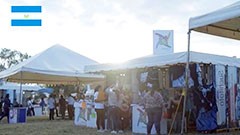What is OVOP (One Village, One Product Movement)?

OVOP fair in El Salvador. El Salvador is the country that has introduced OVOP earlier than other countries in Central America.
JICA is promoting a wide-area expansion of aid in Latin America utilizing the concept of OVOP (One Village, One Product Movement) to revitalize the local economy and strengthen the capacity of the community.
OVOP is the movement structured by the government but led by local residents voluntarily, based on the concept of developing one village by promoting at least one product where regional resources such as local agricultural products, specialty products, and tourism resources are accepted not just locally but worldwide.
We produced JICA-Net multimedia-based learning materials "One Village, One Product Movement-OVOP-The challenge for Community Revitalization" (external link) to deepen the understanding of OVOP practiced in Japan and overseas.
Learning from concrete examples of OVOP
OVOP has originated in 1979, in Oita prefecture, Japan. It was difficult to make a living only from farming or primary industry at the time, and it was inevitable that young people in rural areas immigrated to big cities looking for better employment and opportunities.
For that reason, local residents in several rural areas in the prefecture, initiated community revitalization activities that reviewed local resources and added new values and differentiation to the products to proceed with promotion and sales.

In Ama town, the public and private sector have been working on the community revitalization together. As the result, about 100 new residents from off the island relocate and return every year.
Mr. Hiramatsu, governor of Oita Prefecture at the time, integrated the advances of those activities initiated by local residents under the name "One Village, One Product movement", and that was the beginning.
Then, the concept of OVOP has spread over the country and transformed from "specialty product" branding focused on local products to "local branding" where the framework has expanded greatly to make the whole region attractive.
The material introduces some cases of local branding in Japan: Oita Prefecture where the OVOP has originated, Kamikatsu town in Katsuura District in Tokushima Prefecture where the declining population was aging rapidly but local residents revitalized the town with leaf business "Irodori", Ama town in Oki Islands in Shimane Prefecture where islanders aim at local branding by making use of the things they have themselves with the slogan "Nai mono ha nai" which means "if there isn't, there isn't ", and Kanra town in Kanra District in Gunma Prefecture that emphasizes agritourism and patchwork farming and receives many young people from Japan and overseas.
In the second half, the material shows how OVOP which started in Japan expanded overseas and explains the cases of 3 countries in Central America: El Salvador, Guatemala, Honduras, and 1 country in South America: Colombia, where JICA supported the OVOP project.
Utilized the material in the online seminar

We utilized the material in the Agri-network online seminar as an introduction to explain OVOP.
We utilized the digest version of the material in the Agri-network online seminar held on October 21th, 2021, as an introduction to explain OVOP.
More than 50 long-term trainees in the field of agriculture, forestry, and fishery, participated.
People tend to have the image that OVOP means promoting and selling only one product (specialty product) by one village (region). However, it covers a much wider range.
The present concept of OVOP is to regard local communities' history, culture, nature, lifestyle, and the people who live there as added values as well as local agriculture products and specialty products, and furthermore, to maximize the local attractiveness by combining them and providing the information comprehensively.
It is important to learn the concept of "local branding" and understand that the leading part of OVOP is not only products but also things and people existing in those communities.
By watching the material firstly, participants were able to grasp the concept image of OVOP within a limited presentation time. Moreover, explaining the examples in the material combined with the lecture content made participants understand deeply.
Everybody can watch the material on JICA-Net Library website and JICA-Net Library YouTube Channel. The material could be utilized in an online event as we did at this time when face-to-face training is difficult to be held. We hope the material became a help to understanding OVOP.
MIYAZAKI Masayuki
JICA Economic Development Department
*The Material(s) mainly applied
One Village, One Product Movement-OVOP-The challenge for Community Revitalization
This material explains JICA's approach in the field of Community Revitalization focusing on "Local Branding" based on the One Village One Product Movement (OVOP) developed in Oita Prefecture and how it has been disseminated to whole country and to world wide, especially in Latin America with showing its background, localization and impact.
The material was created to publicize and disseminate the achievement of Japanese model of Community Revitalization through OVOP Movement which was developed in Oita in 1979 and Local Branding methodology as its successor model showing the good practice of adoption in the world.
Suggested uses for this material include seminars, lectures and training sessions in Japan and abroad.




scroll